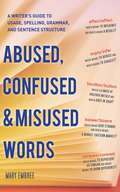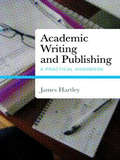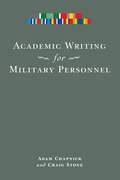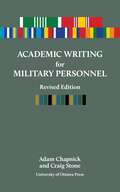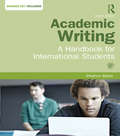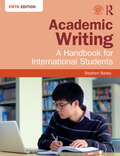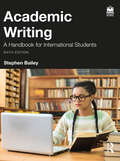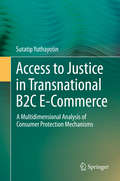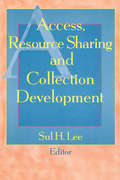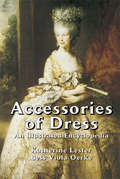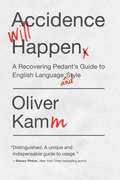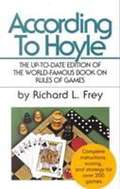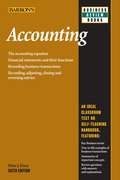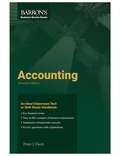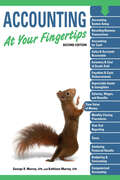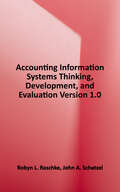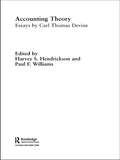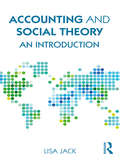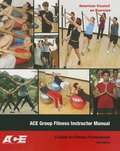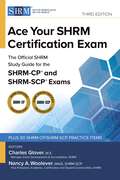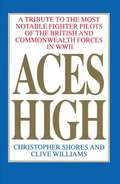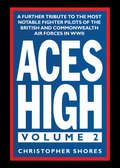- Table View
- List View
Abused, Confused, and Misused Words: A Writer's Guide to Usage, Spelling, Grammar, and Sentence Structure
by Mary EmbreeHave you been putting bullion in your soup? Is incorrect spelling starting to have a negative affect on your term papers? Do you wonder what someone is inferring when they tell you to pick up a dictionary? These are just a few of the commonly misunderstood words discussed and explained in Abused, Confused, and Misused Words, an entertaining and informative look at the ever-changing nature of the English language. An alphabetical list of words that are frequently misspelled or misused is accompanied by a style guide to usage rules that tells you how and why they can be broken. Also included is a collection of 1,000 new and inventive words, and nearly 30,000 more words are discussed in a section dealing with word roots and how they are used in modern language. Anyone who is intrigued by language, who is fascinated by words, or who simply wants to use our language clearly and effectively will enjoy this delightful, eye-opening collection.
Academic Writing and Publishing: A Practical Handbook
by James HartleyAcademic Writing and Publishing will show academics (mainly in the social sciences) how to write and publish research articles. Its aim is to supply examples and brief discussions of recent work in all aspects of the area in short, sharp chapters. It should serve as a handbook for postgraduates and lecturers new to publishing. The book is written in a readable and lively personal style. The advice given is direct and based on up-to-date research that goes beyond that given in current textbooks. For example, the chapter on titles lists different kinds of titles and their purposes not discussed in other texts. The chapter on abstracts instructs the reader on writing structured abstracts from the start.
Academic Writing for Military Personnel
by Adam Chapnick Craig StoneAcademic Writing for Military Personnel is written for members of the military who are either new to or re-entering the academic community and who need to familiarize themselves with academic writing. The authors, an experienced writing instructor and a retired military officer, show how persuasive academic writing enhances officers’ effectiveness in their regular duties, especially as they reach more senior levels of service. They explain the differences between staff writing and academic writing, and outline some of the common errors military personnel make when transitioning from one to the other. The book’s chapters outline the value of strong written communication skills, the research process, the writing process, academic referencing, and frequent grammatical and syntactical errors. Specific examples chosen with a military audience in mind are integrated throughout the book to provide the reader with relevant and practical guidance. The book concludes with a discussion on how officers can use the knowledge they have acquired through their professional experiences in their academic work. As the only comprehensive guide to effective academic writing designed specifically for military personnel, this book will be a crucial addition to the libraries of junior and senior officers in militaries worldwide.
Academic Writing for Military Personnel, revised edition: Revised Edition (Standalone titles)
by Adam Chapnick Craig StoneAcademic Writing: A Guide for Military Personnel est un manuel de rédaction conçu pour aider le personnel militaire à rédiger des travaux savants dans un style clair et efficace. Fruit de la collaboration entre un professeur d’écriture chevronné et un officier militaire à la retraite, le manuel s’adresse aux membres des forces armées qui rejoignent le monde universitaire et qui ont déjà rédigé dans un contexte professionnel militaire ou qui n’ont aucune expérience de la rédaction. En plus d’enseigner aux officiers comment rédiger efficacement, cet ouvrage explique en quoi la maîtrise des techniques de rédaction est utile au personnel des forces armées dans leurs tâches régulières, en particulier aux échelons supérieurs. L’ouvrage traite de l’importance de savoir communiquer par écrit, de ce qui distingue la rédaction savante de la rédaction professionnelle, des processus de recherche et de rédaction proprement dite, du professionnalisme dans la sphère universitaire ainsi que des problèmes et défis fréquemment rencontrés par les rédactrices et les rédacteurs. Un dernier chapitre novateur traite de la manière dont les officiers peuvent mettre à profit les connaissances qu’ils ont acquises par leurs expériences professionnelles dans le contexte universitaire. Des exemples concrets — à l’usage particulier des militaires — sont présentés tout au long du texte pour guider la lectrice et le lecteur de manière pratique et pertinente.Cette édition révisée comprend de nouveaux exemples provenant d’une plus grande variété d’auteurs. Elle prend en compte l’évolution récente des technologies de communication et reflète les nouvelles avancées dans les domaines de l’enseignement et de l’apprentissage.Cet ouvrage, qui est le seul guide exhaustif sur la rédaction à l’usage du personnel militaire, est un ajout incontournable à la bibliothèque de tout officier militaire où qu’il se trouve et quel que soit son rang.Ce livre est publié en anglais. Note : Une version française de ce livre sera disponible en 2023.Formats disponibles : couverture souple, PDF accessible et ePub accessible
Academic Writing: A Handbook for International Students
by Stephen BaileyMost international students need to write essays and reports for exams and coursework, but writing good academic English is one of the most demanding tasks students face. This new, fourth edition of Academic Writing: A Handbook for International Students has been completely revised to help students reach this goal. The four main parts of Academic Writing are: The writing process Elements of writing Vocabulary for writing Writing models Each part is divided into short units which contain examples, explanations and exercises, for use in the classroom or for self-study. The units are clearly organised to allow teachers and students find the help they need with writing tasks, while cross-referencing allows easy access to relevant sections. In the first part, each stage of the writing process is demonstrated and practised, from selecting suitable sources, reading, note-making and planning through to re-writing and proof-reading. The fourth edition of this popular course builds on the success of the earlier editions, and has a special focus on the vital topic of academic vocabulary in part three, Vocabulary for Writing. Part three deals with areas such as nouns and adjectives, adverbs and verbs, synonyms, prefixes and prepositions, in an academic context. More key features of the book include: All elements of writing are clearly explained, with a full glossary for reference Models provided for all types of academic texts: essays, reports, reviews and case-studies Full range of practice exercises, with answer key included Use of authentic academic texts A companion website offers further practice with a range of additional exercises Fully updated, with sections on finding electronic sources and evaluating internet material All international students wanting to maximise their academic potential will find this practical and easy-to-use book an invaluable guide to writing in English for their degree courses.
Academic Writing: A Handbook for International Students
by Stephen BaileyNow in its fifth edition, Academic Writing helps international students succeed in writing essays and reports for their English-language academic courses. Thoroughly revised and updated, it is designed to let teachers and students easily find the topics they need, both in the classroom and for self-study.The book consists of five parts: The Writing Process Elements of Writing Language Issues Vocabulary for Writing Writing Models The first part explains and practises every stage of essay writing, from choosing the best sources, reading and note-making, through to referencing and proofreading. The four remaining parts, organised alphabetically, can be taught in conjunction with the first part or used on a remedial basis. A progress check at the end of each part allows students to assess their learning. All units are fully cross-referenced, and a complete set of answers to the practice exercises is included.New topics in this edition include Writing in Groups, Written British and American English, and Writing Letters and Emails. In addition, the new interactive website has a full set of teaching notes as well as more challenging exercises, revision material and links to other sources. Additional features of the book include: Models provided for writing tasks such as case studies and essays Use of authentic academic texts from a wide range of disciplines Designed for self-study as well as classroom use Useful at both undergraduate and postgraduate level Glossary to explain technical terms, plus index Written to deal with the specific language issues faced by international students, this practical, user-friendly book is an invaluable guide to academic writing in English.
Academic Writing: A Handbook for International Students
by Stephen BaileyThe new sixth edition of this popular book has been written to help international students succeed in writing essays and reports for their English-language academic courses. Thoroughly revised and updated in a streamlined format making it even easier for students and teachers to use, Academic Writing: A Handbook for International Students is designed to let readers find the support they need easily, both in the classroom and for self-study.The book consists of three parts, comprising a total of 28 units: The Writing Process and Writing Skills; Elements of Writing; and Writing Models. The first part explains and practises every stage of essay writing, from choosing the best sources, reading and note-making, through to referencing and proofreading. These stages are supported by relevant explanations of critical writing skills, so that, for instance, finding synonyms is linked with paraphrasing and summarising. The second part explains critical issues such as using numbers and punctuation, and is organised alphabetically, while the third part provides models for common components of student writing such as case studies and reports. All units are fully cross-referenced and can be taught in conjunction with each other or used for self-study or reference. A progress check at the end of each part allows students to self-assess their learning, and a complete set of answers to the practice exercises is included.Additional features of the book include: Use of authentic academic texts from a wide range of disciplines Designed for self-study as well as classroom use Useful at both undergraduate and postgraduate level Fully updated, with sections on using AI and exploring electronic sources Access to the free interactive website which includes a full set of teaching notes as well as more challenging exercises, revision material and links to other sources. All international students wanting to maximise their academic potential will find this practical and easy-to-use book an invaluable guide to writing in English for their degree courses.
Acceptable Methods of Aircraft Inspections and Repair: AC 43.13-1B/2B
by Federal Aviation AdministrationThis advisory circular (AC) contains methods, techniques, and practices acceptable to the Administrator for the inspection and repair of nonpressurized areas of civil aircraft, only when there are no manufacturer repair or maintenance instructions. This data generally pertains to minor repairs. The repairs identified in this AC may only be used as a basis for FAA approval for major repairs.
Access to Justice in Transnational B2C E-Commerce: A Multidimensional Analysis of Consumer Protection Mechanisms
by Sutatip YuthayotinThis book identifies institutional mechanisms that can be used to promote consumer confidence in direct online sales with businesses (B2C e-commerce). It argues that enhancing the access to justice in a multidimensional sense can potentially offer an effective means of boosting consumer confidence. It introduces a conceptual framework for a multidimensional approach to access to justice in the context of consumer protection, describing the various reasonable criteria needed to satisfy consumer demands in B2C e-commerce. The framework, which reflects all essential aspects of consumers' expectations when they engage in online transactions, provides a benchmark for the evaluation of various consumer protection mechanisms. Based on an analysis of different mechanisms and using the framework's criteria, the practice of private ordering, which does not rely on the creation of rules of law but rather on the use of technology as a solution, appears to offer a meaningful way to enhance access to justice in B2C e-commerce. However, though private ordering holds considerable potential, certain weaknesses still need to be eliminated. This book demonstrates how private ordering can be successfully implemented with the help of an intermediary, a neutral third party that plays an integral part in the collaborative task of facilitating various aspects of private ordering, thus helping to limit the risks of failure and ensuring a fairer market setting. In order to move forward, it argues that the state, with its wealth of material resources and incentive options, is the institution best suited to acting as an intermediary in facilitating private ordering. This promising proposal can improve consumer protection, which will in turn boost consumer confidence.
Access, Resource Sharing and Collection Development
by Sul H LeeAccess, Resource Sharing, and Collection Development explores the role of libraries in acquiring, storing, and disseminating information in different formats to help you better use technology to share scarce resources and connect library users with collections. With an expressed goal of encouraging continued debate and further investigation, this book provides you with developing strategies and procedures to meet the challenges you face as a collection development librarian during this dynamic time. Among the vital concerns addressed are the competition for limited resources, trends in document delivery, the evaluation of document delivery products, and libraries’options for the future.The chapters collected in Access, Resource Sharing, and Collection Development represent the proceedings of the annual conference held by the University of Oklahoma Libraries and the University of Oklahoma Foundation. The book provides insight into your peers’findings and ideas on: access vs. ownership the future role of the bibliographer changes in collection management managing restrained resource budgets an emphasis on the library user as customer the growth and acceptance of document delivery as a component of collection development and ILL electronic publishing and copyright issues commercial document delivery services Access, Resource Sharing, and Collection Development also shows you how to discover and evaluate "free" resources on the Internet, as standards for production, promotion, and maintenance are nonexistent. The challenge of using these materials is being met by developing criteria for selection, looking at cataloging options, and working in cooperation with other institutions. You’ll also learn the different options for document delivery and how to evaluate document delivery products. Among the book’s advice: you should consider the types of document delivery available, examine the benefits of combining outside services with in-house systems, review the criteria for selecting technologies and suppliers, and explore examples of institutions creating customized systems.
Accessibility Guidelines and Standards for Higher Education Institutions and Universities
by Ministry of Education University Grants CommissionAccessibility Guidelines and Standards for Higher Education Institutions and Universities is a transformative book that delves into the realm of higher education and the inclusion of persons with disabilities. Drawing upon the guidelines and standards set by the University Grants Commission (UGC), the book explores the imperative need for accessible mechanisms in Higher Educational Institutions (HEIs) and Universities. It delves into the United Nations Convention on the Rights of Persons with Disabilities (RPWD) Act and the National Education Policy (NEP) 2020, emphasizing their role in promoting inclusive education. Through comprehensive coverage of diverse aspects, including support provision, accessible resources, inclusive infrastructure, curriculum adaptation, and assessment systems, the book provides practical insights for HEIs to develop an inclusive environment. Additionally, it highlights the importance of inclusive campus life, governance, and monitoring to foster an empowering educational journey for persons with disabilities. Accessibility Guidelines and Standards for Higher Education Institutions and Universities is a guiding light for educators, administrators, policymakers, and advocates seeking to create a truly inclusive higher education landscape.
Accessible E-Content Creation Standards and Guidelines
by Bookshare XrcvcThis document/book lists the standards of and provides guidelines on creating accessible e-content from Mircosoft Word. These standards are intended to help NGOs, libraries, book production agencies and volunteers prepare a digital copy of books in Microsoft Word with a view to further convert it to accessible formats such as EPUB, accessible PDF and DAISY formats with minimal modifications.
Accessories of Dress: An Illustrated Encyclopedia
by Bess Viola Oerke Katherine LesterDrawing upon a vast number of historical sources, the authors of this useful reference have created an entertaining account of the forms of personal adornment men and women have used throughout the ages to enhance their wearing apparel. From hats, veils, wigs, and cosmetics, to cravats, shawls, shoes, and gloves, to walking sticks, handbags, fans, and furs, the engaging commentary displays the humor and personal charm of the many-sided story of accessorized apparel. 644 figures and 59 plates.
Accidence Will Happen: A Recovering Pedant's Guide to English Language and Style
by Oliver KammA witty, authoritative, and often provocative guide to the use and abuse of the English language, by the London Times's lead grammar columnist. Are standards of English alright—or should that be all right? To knowingly split an infinitive or not to? And what about ending a sentence with preposition, or for that matter beginning one with "and"? We learn language by instinct, but good English, the pedants tell us, requires rules. Yet, as Oliver Kamm cleverly demonstrates in this new book, many of the purists' prohibitions are bogus and can be cheerfully disregarded. Accidence Will Happen is an authoritative and deeply reassuring guide to grammar, style, and the linguistic conundrums we all face.
According To Hoyle
by Richard L. FreyOFFICIAL RULES OF MORE THAN 200 POPULAR GAMES OF SKILL AND CHANCE WITH EXPERT ADVICE ON WINNING PLAY
Accounting (Barron's Business Review Series)
by Peter J. Eisen<p>Like the other titles in Barron’s Business Review Series, the new sixth edition of Accounting makes a useful supplement to college textbooks, and is also excellent as a main text in business brush-up programs. Author Peter J. Eisen familiarizes students with key accounting terms, explains the accounting equation, and goes on to instruct in the use and preparation of financial statements, the recording of business transactions in journals, and in closing and adjusting entries at the end of a business period. <p>The book is organized to closely follow a standard college textbook, but concentrates on student understanding of what is done, and, more importantly, how and why. Other helpful features include: Review questions; Computational problems with complete detailed solutions presented when appropriate; Additional problems to reinforce the reader’s knowledge; An extensive glossary of accounting terms. <p>New features in this edition include instruction in the use of spreadsheets to solve many accounting problems, a more detailed explanation of accounting data procedures as internal controls designed to safeguard assets, and extensive commentary on business ethics.</p>
Accounting (Barron's Business Review)
by Peter J. EisenLike the other titles in Barron&’s Business Review Series, this Seventh edition of Accounting makes a useful supplement to college textbooks, and is also excellent as a main text in business brush-up programs. Author Peter J. Eisen familiarizes students with key accounting terms, explains the accounting equation, and goes on to instruct in the use and preparation of financial statements, the recording of business transactions in journals, and in closing and adjusting entries at the end of a business period. The book is organized to closely follow a standard college textbook, but concentrates on student understanding of what is done, and, more importantly, how and why. Other helpful features include: Review questions Computational problems with complete detailed solutions presented when appropriate Additional problems to reinforce the reader&’s knowledge An extensive glossary of accounting terms. This edition includes instruction in the use of spreadsheets to solve many accounting problems, a more detailed explanation of accounting data procedures as internal controls designed to safeguard assets, and extensive commentary on business ethics.
Accounting At Your Fingertips, 2e (At Your Fingertips)
by George R. MurrayMost small business owners learn early on that it's much cheaper to do their own books (alone or with the assistance of a bookkeeper or accounting clerk) and have them reviewed by an accountant than to have a CPA on staff. With a steady supply of entrepreneurs opening new businesses, there's a real need for a one-stop accounting reference busy owners, bookkeepers, and accounting clerks can use to access the specific information they need quickly and accurately. Accounting at Your Fingertips, Second Edition, helps readers pinpoint the precise information they need on any accounting topic without wasting time. Divided into concise but complete bites that are easy to find and easy to understand, Accounting at Your Fingertips, Second Edition, covers all topics related to the monthly accounting process. Based on the notion that time is the scarcest commodity of all, this book is organized to allow readers the shortest path to the information they need, including: Organization and proper accounting procedures. Creating a chart of accounts and balance sheet accounts. Posting accounts to the general ledger. Reporting assets and expenses. Handling receivables, payroll, and cost of goods and services. Posting salaries, wages, and payroll taxes. End-of-month accounting tasks and procedures. Producing balance sheets, profit and loss statements, and end-of-year payroll reports. Closing the books at the end of the year.
Accounting Information Systems: Thinking, Development, and Evaluation Version 1.0
by Robyn L. Raschke John A. SchatzelThis book's key goal is to provide students with a basic understanding of AIS terminology and topics in an approachable way. As a result, the writing style is intentionally crafted to be easy to understand for students who are new to accounting information and related decision-making responsibilities. Further, there is a strong focus throughout on emerging accounting technologies such as distributive ledgers including blockchain, smart contracts, robotic process automation, machine learning, and artificial intelligence (AI). Including these topics in more meaningful ways exposes students to new technologies’ impacts on accounting. Further, such coverage encourages them to develop an inquisitive and flexible mindset based on the premise that an AIS is not static. As a result, students learn an AIS must be continuously assessed and re-evaluated in order to keep pace with constant organizational change, the introduction of new technologies, and an ever-evolving regulatory environment. Finally, the narrative is consistently organized around three key perspectives: the user, design, and control. These three organizing themes support and guide the learner's journey through understanding how accountants use information to make decisions, how an AIS works, and how to recognize and minimize the threats to an AIS.
Accounting Theory: Essays by Carl Thomas Devine (New Works In Accounting History Ser.)
by Harvey S. Hendrickson Paul F. WilliamsOne of the outstanding accounting theoreticians of the twentieth century, Carl Thomas Devine exhibited a breadth and depth of knowledge few in the field of accounting have equalled. This book collects together eight previously unpublished essays on accounting theory written by Professor Devine.Professor Devine passed away in 1998, prior to the sign
Accounting and Social Theory: An introduction
by Lisa JackIs society possible without accounting? In speech or in writing, we communicate actions, plans and decisions using numbers, calculations, words and images. Although accounting research is dominated by quantitative analyses, the role of accounting in society is firmly established over thousands of years. In this concise book, Lisa Jack demonstrates the power of social theory in expanding the value of accounting research. Accounting and Social Theory: An introduction includes advice on research problems as well as guidance on fertile areas for new research. The tools, techniques and developments covered by the author help readers to see social research in accounting as the study of the use, misuse and abuse of accounting communications by people and the effects that this has on social relationships. Stories of accounting in war, agriculture and food, gender, health and other areas illustrate the ways in which the threads of accounting run through society. Having emerged from the author’s wealth of teaching experience, this book provides a student-focused treasure trove that illuminates the field for early-career researchers in accounting and established academics looking to expand the impact of their work.
Ace Group Fitness Instructor Manual: A Guide for Fitness Professional
by AceThe all-new ACE Group Fitness Instructor Manual, 3rd Edition, prepares fitness professionals to design effective group fitness programs and both safely and successfully lead a wide range of class formats and participants. A must-have resource for group fitness instructors, the manual addresses critical core competencies regardless of the types of classes you plan to teach. Topics range from instruction techniques and program design to the business of group fitness and an instructor's ethical and legal responsibilities as well. Additionally, the manual tackles important considerations that group fitness instructors face when instructing a variety of individuals, including pregnant women and those with significant weight challenges. The manual includes an all-new companion DVD, Essentials of Group Fitness Instruction, on which world-renowned group fitness expert and award-winning presenter, Lawrence Biscontini, offers essential steps and strategies to unlocking the critical elements of group fitness. Discover key components of class design, such as how to determine desired outcomes through exercise and movement selection, sequencing, choreography, program modifications and music.
Ace Your SHRM Certification Exam: The OFFICIAL SHRM Study Guide for the SHRM-CP® and SHRM-SCP® Exams
by Charles Glover and Nancy A. Woolever, editorsPreparing for the SHRM-CP® and SHRM-SCP® certification exams can be daunting-but it doesn't have to be, if you have the official SHRM study guide. This concise, accessible guide helps HR professionals understand the structure of both exams and equips them with the tools to succeed. With 50 original practice questions, expert test-taking strategies, tips for managing anxiety and research-based study techniques, this resource is designed to build confidence and sharpen performance. It also includes glossaries of key terms and acronyms, practical advice from test-takers and curated study resources to guide your prep from start to finish.Whether you're just beginning or nearing test day, this guide offers everything you need to prepare with purpose and pass with confidence.
Aces High, Volume 1: A Tribute to the Most Notable Fighter Pilots of the British and Commonwealth Forces of WWII
by Christopher Shores Clive WilliamsFirst in the Aces High series—a military reference of the fighter pilots who had five or more confirmed victories while serving in the Royal Air Force. Introduced by the French quite early in World War I, the term &“ace&” was used to describe a pilot credited with five or more aerial victories. But in the United Kingdom, the term was never officially recognized. Becoming an ace was partly luck, especially considering the campaigns in which they flew and the areas of combat. There are three distinct kinds of aces: the defensive ace, the offensive ace, and the night fighter. This book is a revised collection of the biographies of the highest scoring Allied fighter pilots of World War II—including those with the confirmed claims of shooting down five aircraft and those pilots with lower scores but whose wartime careers prove them worthy of inclusion. All details of their combat are arranged in tabular form. Included are a selection of photographs from hitherto private collections. &“There are some authors whose name alone is sufficient reason to but a book, and Christopher Shores is surely one of these . . . By profession a chartered surveyor, he served in the Royal Air Force in the 1950s so his writing bears the stamp of authenticity.&” —HistoryNet
Aces High, Volume 2: A Further Tribute to the Most Notable Fighter Pilots of the British and Commonwealth Air Forces in WWII
by Christopher ShoresSecond in the Aces High series—an updated military reference of the fighter pilots who had five or more confirmed victories while serving in the RAF. This volume updates the information in the first volume and adds some new names. Information has been added on the pilots who gained success against the V-1 flying bombs during 1944-45. Detail is also provided on those units in which virtually all the fighter pilots served at some time or another—the fighter Operational Training Units—and of specialist units such as the Central Gunnery School, Fighter Leader&’s School and Fighter Experimental Units. There is also coverage of the only other conflicts in which British pilots have been able to claim victories since 1945—Korea and the Falklands Conflict. &“There are some authors whose name alone is sufficient reason to but a book, and Christopher Shores is surely one of these . . . By profession a chartered surveyor, he served in the Royal Air Force in the 1950s so his writing bears the stamp of authenticity.&” —HistoryNet
